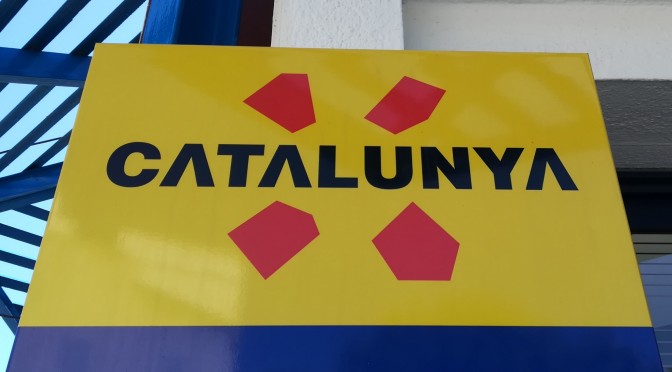.
Un cop caminades Tailàndia, Birmània, Bangladesh, Índia, Pamir, Tadjikistan, Uzbekistan, Iran, Azerbaidjan, Geòrgia, Turquia, Grècia, Macedònia, Albània, Montenegro, Bosnia-Hercegovina, Croàcia, Eslovènia, Itàlia i França amb aproximadament uns 15.700 quilòmetres als peus, ara finalment arribem a CATALUNYA, arribem a casa nostra !!!!
****
Wow! We finished France, and have crossed into CATALONIA!!!! Yes, with around 15,700 kilometers on our feet, we are really, truly in the home stretch!!
Before we go into final countdown mode, let’s pause and reflect on our time in France.
Català / Catalan
L’aventura començà al gener del 2016 a Tailàndia, per després passar a Birmània, on les altes temperatures i humitat ens van marcar un dur inici d’aventura.
A continuació vàrem saltar a Àsia central per poder caminar a través de les majestuoses muntanyes del Pamir i després Tadjikistan, durant uns mesos encara primaverals.
Arribà un terriblement calorós juliol, on creuar el desèrtic Uzbekistan ens va fer suportar temperatures extremadament altes, seques i asfixiants.
Pamir, Tadjikistan i Uzbekistan les vàrem fer abans de Bangladesh i Índia per evitar el duríssim hivern a Àsia Central i també l’asfixiant monsó al sud-est asiàtic.
Vàrem reprendre la ruta a Bangladesh, un pèl massa aviat per que les primeres setmanes ens ofegàvem de calor, humitat i en alguna que altra tempesta de final de monsó. Entrar a continuació a l’Índia per passar tot un llarg hivern ens va regalar perfectes temperatures diürnes, però poques hores de llum amb fredes nits i matinades, on la boira espessa ens va acabar de congelar. L’operació quirúrgica de Jenn va marcar una important fita durant l’estada a l’Índia.
Des de maig a juliol vàrem caminar Iran on la seva absoluta i increïblement hospitalària gent ens va deixar bocabadats. Les paraules generositat i hospitalitat mai més tindran el mateix significat per nosaltres, després del nostre pas per la cultura farsi. Aquelles persones no són d’aquest planeta i sempre, sempre, els estarem immensament agraïts i els portarem dins els nostres cors.
Creuar a continuació Azerbaidjan durant un agost severament calorós va ser un calvari que ens va causar molts problemes, però després vàrem gaudir d’un molt bon setembre a través de les muntanyes, valls i rius del sud de Geòrgia.
A continuació vàrem estar molt de temps creuant la llarga Turquia resseguint la mar Negra, per després passar a la mar de Marmara.
Seguidament vàrem entrar a Europa pel nord de Grècia, bressol de la nostra civilització, per començar-nos a endinsar en els molt complicats Balcans a través de les muntanyes i llacs de Macedònia, l’hospitalària Albània i Montenegro.
Vàrem triar una ruta en paral·lel a la costa, al llarg de la molt depriment Bòsnia-Hercegovina que sembla ancorada en el seu violent, molt complex i mal resolt passat recent. Després vàrem creuar el nord de Croàcia i també un breu, bonic i natural tram d’Eslovènia.
Últimament hem caminat a través del molt industrialitzat i agricolament ric nord de la ‘bella’ Itàlia on la simpatia i sovint, generositat dels seus habitants, ens ha agradat molt. Abans d’arribar al nostre país, hem entrat a França per una preciosa i nevada porta, el Coll de la Madeleine, de temperatura tan freda com la majoria de les persones que hem vist i amb les que decepcionantment gairebé no hem parlat gens.
Ara finalment arribem a la nostra terra, la nostra nació, la nostra estimada Catalunya. Volem seguir la ruta GR92 tal i com vàrem fer ara fa cinc anys . Caminarem majoritàriament per la preciosa costa, però també tindrem l’oportunitat de gaudir d’alguns dels nostres boscs mediterranis.
Tenim previst arribar a Barcelona, final de la nostra ruta, la nostra aventura, el nostre somni i repte, el proper dissabte 29 de juny, tal i com ja vàrem anunciar recentment aquí.
De nou i com venim fent des de fa setmanes, mesos i fins i tot anys, penseu que el vostre interès i recolzament ens ha ajudat moltíssim i volem reiterar que us estem MOLT agraïts.
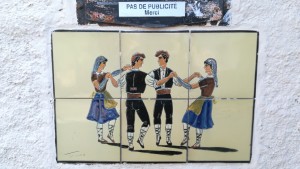

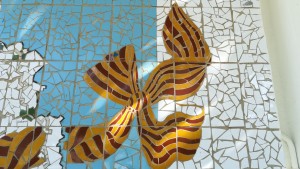
Mapa general amb la nostra ruta a través de França. / General map with our route marked through France
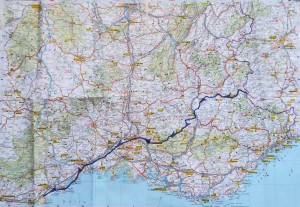
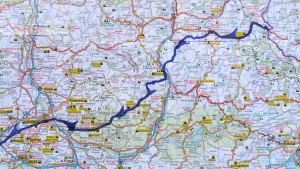


****
English version / Anglès
France. Well, what can we say about our 5 weeks walking there? The first words that come to my mind are: Pretty and varying landscapes; super windy, with the north/northwest Mistral nearly knocking us down several times for a few weeks; expensive (21-26 euros for a lunch menu??? Way out of our budget!), and sprinkled with some fun moments with some special people, but, overall, disappointing.
Disappointing? Why? Let me put it in some context.
We always enter countries without many expectations and try to mute our pre-conceived opinions and judgements. It’s not easy to do, especially since we have traveled so much before this walk and have experienced such a range of things during this 3.5-year foot journey. Generally, our motto as we move through new places is, “Let’s see how it goes. Let’s see what this place and these people are like. Let’s stay open to invitations, and say yes to life, wherever it leads.”
One thing we noticed but only starting putting words around these last few weeks is how different the gates, fences and walls have become as we keep heading west.
In the developing Asian countries we have passed through, there are often no gates or fences around people’s houses. Houses are usually on the road, literally right up alongside the edge of the asphalt. We saw people tilling their fields nearby, taking their animals out to pasture, sweeping the dust off away from their front door, or heading to the small family shops in front of their houses where they work. They are often curious about us, brave enough to approach us and talk to us (despite language barriers), and most generously invite us into their homes and share whatever they have with us. We are guests, and many of them feel it is their responsibility and duty to offer hospitality, take care of us, and treat us with respect and kindness.
Some of this vibe started to shift as we moved through Turkey, Greece and the more developed parts of the Balkans, namely Croatia and Slovenia. In those areas, houses are set further away from the streets. Short, thigh-high fences or gates line the perimeter of houses, and delineate the yard from the sidewalk. But the fences, typically lined with rose bushes, fruit trees and other flowering plants, still provide a view into pieces of the owners’ domestic lives. We think some of this is ego and pride driven, something that says, “Look. We’re doing pretty well, or at least we are doing better than some of our neighbors.” And, people in these regions, were still within arm’s reach from us, and many of interactions happened at coffee shops or when they were sitting outside on their porches with their neighbors or working in their gardens. We were obviously not from there, and their hospitality traditions are strong enough to extend a helping hand our way. We were invited to cross the fence, many times, to have a coffee or a tea, and maybe some cookies or even a bigger meal.
By the time we reached Italy, property dividing lines were protected with neck-high fences and by one, two, three, six dogs. Signs posted nearly on every house and at the entrance of every town warned about video surveillance and neighborhood crime watch programs. Northern Italy is obviously richer and more industrialized than other places we have been, and people have more valuable things they feel need to be better watched over. But, Italians are pretty social people, and, along with the congratulatory Bravissimo and Complenti hand shakes, came many unexpected and always-welcome invitations to share life together in the form of a coffee, a meal (which usually included pasta, wine and cheese), a shower or a night inside away from the cold dampness.
When we reached France the beginning of May 2019, almost immediately, we started noticing the high walls edging gardens, homes and lives. Some of the houses originally had smaller, waist-high walls, just enough to mark property division. But, over the years, many people have planted trees and thick bushes, which now have grown high and wide enough to prevent any view of the house or the kind of life lived behind the barricade. Newer houses have concrete walls that often are more than two meters high (more than six feet), and the message seems clear to us: You stay on your side of the wall, and I will stay on my side.
This made France feel unwelcoming, and its people unapproachable and stand-offish. It’s hard not to feel the intentional distancing they want to keep, not just from strangers, but from each other.
And, that’s why we were disappointed. Beyond the now-and-again “bonjour,” we had very few chances to interact with locals. Some days, we spoke with more horses we found grazing in the fields than humans. So we leave the country with the same sort of distant feeling many French people create. It’s sad for us, but as the French “C’est la vie,” that’s life. We do also find it ironic that we are missing the human interaction enough to note it; in many parts of Asia, and especially in India where people constantly popped in front of us to take selfie photos, we were frequently worn out and aggravated by the unrelenting need of others to talk to us.
Even though we feel let down, we are not saying leave empty-headed or empty-hearted.
We had many beautiful days of walking off-road on dirt trails in total silence or tuning into the different bird songs we heard as we moved from the mountains down to valleys and through orchards and vineyards and along canals and the seaside.
We also had incredible and deep, enriching conversations with a handful of people, including some dear Couchsurfing hosts, fellow travellers who took us in for a few nights. We swapped travel stories, spoke about politics, cooked meals together, and learned about fossils and rock-climbing.
We did, too, have a few spontaneous encounters that touched our hearts and made our journey lighter for a few hours. There were the two ladies in a small village in the mountains – one who offered us coffee, and the other who made us lunch; the fisherman who let us camp on the fishing club’s terrace, grilled us a couple trouts and filled plastic cups with chilled rose wine, and the guy near the beach, who is also wandering around Europe with a backpack and his van and bought us ice cream on a hot afternoon.
Again, we don’t expect anything from anyone we meet in any place we walk. And we do our best to be neutral observers to the lives we pass by and get glimmers of at three kilometers an hour. However, we are constantly surprised at how the world greets strangers, and when and how an invitation comes to us.
Memories of all these people and the moments we shared are a huge part of what makes this walk so special and, often, are the reasons for us to keep walking – – we become excited about what else we can discover, learn, absorb, and appreciate further along the way
With that same willingness and excitement, we step into our home turf, a place where we are not strangers, where we speak the same language, and where we long to be.
What surprises do Catalonia and Catalans have waiting for us? Let’s go find out!
Admin notes: You know the drill by now… when we change countries, we have no idea what our connectivity will be like or how soon we’ll be back online.
Although we’re back on home field and using our regular SIM cards, keeping our phones charged is always an issue, especially when thru-hiking on the GR 92 coastal trail, which we will be on most of our way down to Barcelona and which we walked as a training hike five years ago in 2014. Thankfully, there are no plugs in the small sea coves or in the forest!
Rest assured, we’ll be posting here and on our social media feeds as we can, but hopefully with some extra frequency as we excitedly walk towards our finish line in Barcelona. And, you’ll want to check back here soon… We have a wonderful surprise to share with you in a few days!
We also are posting on Instagram and Facebook. Our tag on both pages is @bangkokbarcelonaonfoot. The links are below:
https://www.instagram.com/bangkokbarcelonaonfoot/
https://www.facebook.com/bangkokbarcelonaonfoot/
Thanks for walking with us!

